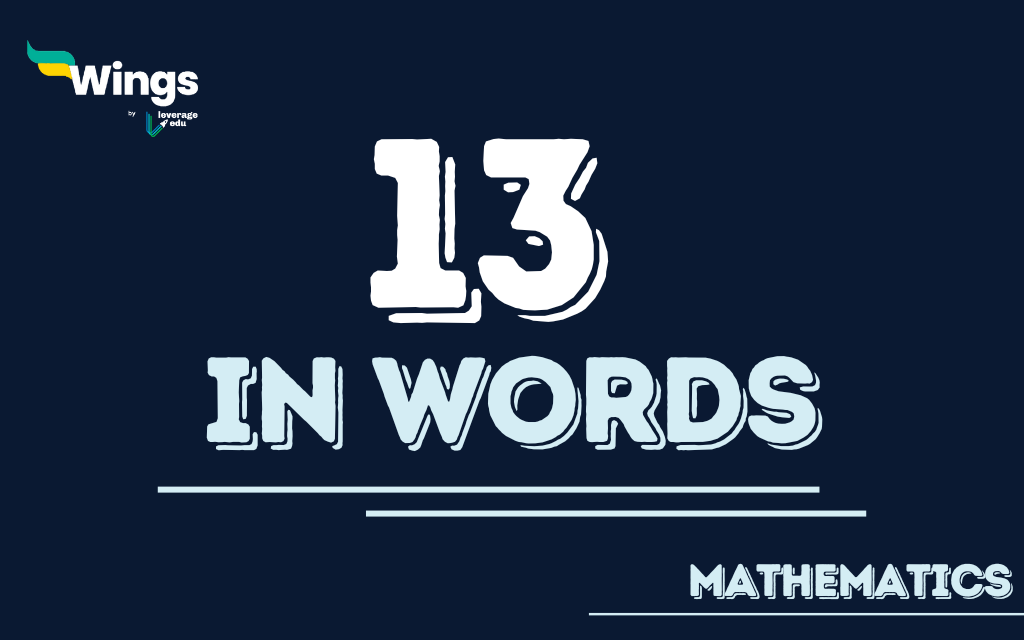Thirteen is a natural number following twelve and preceding fourteen. It holds significance in various contexts. Mathematically, it’s a composite number divisible by 1, 13, and itself. The numeral system, it’s written as 13 using the Hindu-Arabic numerals. So 13 holds a dual significance. Firstly, it acts as a cardinal number. This means it represents a specific quantity. In simpler terms, 13 signifies thirteen units. You can use it to count objects, like having 13 apples in a basket. Secondly, 13 has a designated written form within the English language. Following the established rules for numbers between eleven and nineteen, 13 is “thirteen”. Read this article to learn more about how to convert 13 words into English.
Contents
13 in Words in English
13 in words in English is written as ‘thirteen”. Here we have stated some of the important properties related to 13.
- 13 is an odd number because it leaves a remainder of 1 when divided by 2 (13 ÷ 2 = 6 remainder 1).
- 13 is a prime number. A prime number has exactly two distinct positive divisors: 1 and itself. In this case, the only factors of 13 are 1 and 13.
- The square root of 13 is approximately 3.6056. Since it’s not a whole number, 13 is not a perfect square (a perfect square is a number obtained by squaring an integer).
- 13 is not a perfect cube. A perfect cube is a number that can be obtained by cubing (multiplying by itself three times) another number. 13 does not satisfy this condition (1 x 1 x 1 = 1, which is not equal to 13).
How to Convert 13 in Words?
The place value system allows us to convert numerical representations like 13 into their corresponding written systematically. Within the framework of the base-ten number system, each digit in a number holds a specific value based on its position. This concept is called place value. Here’s how we can use place value to convert 13 into words:
- Identify the Digits and their Places:
- In the number 13, the digit ‘1’ occupies the tens place. This signifies one group of ten units.
- The digit ‘3’ occupies the unit’s place, representing three individual units.
- Constructing the Written Form:
- Numbers from eleven to nineteen have a unique naming convention. We combine the place value of the tens digit (“one” from the tens place) with the specific suffix “-teen” followed by the unit digit (“three” from the unit place).
- Therefore, 13 is written in words as thirteen.
Rules to Write Numbers in English
Here are the important guidelines for writing numbers in words in English :
- Numbers One to Ten: These fundamental numbers are generally written out in full (one, two, three, etc.).
- Numbers Eleven to Nineteen: This range has a unique convention. We combine the tens digit with the suffix “-teen” followed by the units digit (e.g., thirteen, fourteen, fifteen).
- Numbers Twenty and Above (Whole Numbers): For larger whole numbers, numerals are preferred (20, 25, 100, etc.). However, some exceptions exist, particularly when:
- The number begins a sentence. In such cases, it’s generally written out in full for improved readability (e.g., Twenty-three participants were enrolled in the study).
- The number appears in a commonly phrased expression, regardless of magnitude (e.g., a hundred years ago, one million dollars).
Facts of Number 13
The number 13 holds an important position in mathematics, culture, and history. Here we have listed some important facts related to 13:
- 13 is a prime number. In number theory, a prime number has exactly two distinct positive divisors: 1 and itself. The only factors of 13 are 1 and 13.
- 13 is also a Fibonacci number (a sequence where each number is the sum of the two preceding ones) and appears in various mathematical curiosities.
- In some cultures, particularly Western cultures, 13 is associated with misfortune. This association likely stems from historical and mythological references, but it holds no basis in mathematical reality. Conversely, some cultures consider 13 a lucky number.
- The number 13 finds applications in various contexts, from the 13 lunar cycles in a year to the 13 cards in each suit of a standard playing deck. Interestingly, some buildings omit a thirteenth floor due to triskaidekaphobia, the fear of the number 13.
1 to 13 Numbers in Words
This chart is like a cheat sheet to help children learn how to spell numbers 1 to 13 in words in English Here’s the number chart:
| Number | Word |
| 1 | One |
| 2 | Two |
| 3 | Three |
| 4 | Four |
| 5 | Five |
| 6 | Six |
| 7 | Seven |
| 8 | Eight |
| 9 | Nine |
| 10 | Ten |
| 11 | Eleven |
| 12 | Twelve |
| 13 | Thirteen |
FAQs
13 is written as “Thirteen”.
11 to 20 are written as: Eleven, twelve, thirteen, fourteen, fifteen, sixteen, seventeen, eighteen, nineteen, twenty.
15 in words is written as “Fifteen”.
This was all about the “13 in Words”. For more such informative blogs, check out our Study Material Section, or you can learn more about us by visiting our Indian exams page.
 One app for all your study abroad needs
One app for all your study abroad needs














